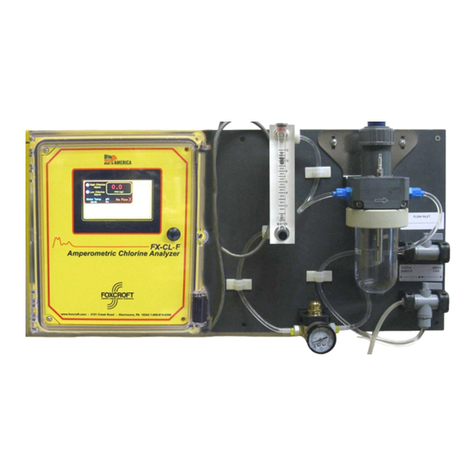
Specications
Operational
Type of Measurement Amperometric (free or total chlorine)
Measurement Range 0-5.00 ppm (mg/l) factory-set range; other eld-congurable
measuring ranges are: 0-0.50; 0-1.00; 0-2.00; 0-3.00; 0-10.0; 0-20.0;
0-0.50; and 0-60.0 ppm (mg/l)
Display Three-digit LED; 0.56 in. (14 mm) high
Ambient Conditions 32-120°F (0-49°C); 0-95% relative humidity, non-condensing
Analog Output One isolated 4-20mA (600 ohms max. load)
Relays Two electromechanical relays (high and low alarms); SPDT (form C)
contacts; rated 1A @ 120 VAC
Power Requirements 100-130 VAC, 50/60 Hz (30 watts); optional 200-240 VAC, 50/60 Hz
Performance
Sensitivity 0.001 ppm (mg/l)
Accuracy +/- 0.25% of full scale
Repeatability 0.004 ppm (mg/l) or 1% of full scale, whichever is greater
Stability +/- 1% of full scale per month
Response Time 4 seconds from sample entry to display indication
Full Scale Response 1.5 to 2.0 minutes
Sampling
Sample Temperature Range 32-120°F (0-49°C)
Sample Flow Rate 150-1000ml/min. (500 ml/min. recommended)
Sample Cell Use 120 ml/min xed
Sample Supply Continuous. Where sample ow is interrupted, provisions must be
made to keep the electrodes wet.
Sample pH Range 3.0-10.0 pH
Sample Alkalinity Range 0.05-350 ppm (mg/l) total
Sample Turbidity Limit Less than 250 NTU
Electrode Materials Cathode (measuring): Gold (24K, 99.95%)
Anode (reference): Copper (99.9%)
Buffer Requirements:
Free Chlorine
Total Chlorine
White distilled vinegar (5% food grade)
White distilled vinegar (5% food grade) mixed with prescribed
amount of potassium iodide (KI)
Mechanical
Enclosure NEMA 4X; berglass; surface mount
System Net Weight 14.8 lbs. (6.7 kg) approximately
Sample Inlet Line 1/4” id x 3/8 od x 3’ length, clear exible PVC tubing
Buffer Feed Line Tubing #14 neoprene tubing (factory-installed)
#13 neoprene tubing x 9” (supplied)
Drain Lines 5/8” id x 3/4” od x 3’ length, clear exible PVC tubing (2)
7





























